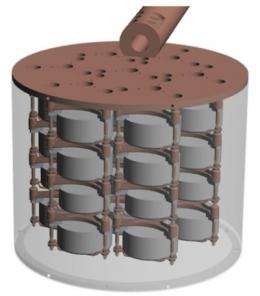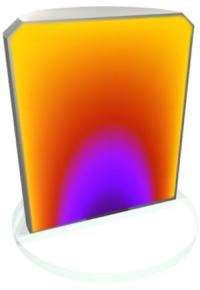Stalking the Neutrinoless Double Beta Decay

(PhysOrg.com) -- The hunt for the elusive neutrino mass has officially begun. This difficult-to-detect elementary particle travels close to the speed of light, is electrically neutral, and can pass through ordinary matter almost undisturbed.
In FY 2010 DOE’s Office of Nuclear Physicsallocated $20 million over the next four years to the Majorana Demonstrator Project, which is aimed at capturing neutrinoless double beta decay events. “If we are able to measure the rate of neutrinoless double decay, we can infer the absolute mass of the neutrino,” said deputy project manager, Dick Kouzes.
Kouzes, a nuclear scientist who has studied this question since the 1980s, says the discovery would lead to a revision of the Standard Model of particle physics that governs the laws of all visible matter in the universe, essentially redefining the laws of physics.
Developed in the 1930s, the original theory that hypothesized the neutrino assumed it had no mass. Later, researchers found neutrinos have three different states, or what the researchers coined as “three flavors.” Experiments to measure solar, cosmic and accelerator-produced neutrinos showed that the neutrino oscillates between these states. Only a particle with a mass could show these flavor oscillations.
But, to date, the neutrino’s mass has not been measured.
In addition to Kouzes, PNNL scientists James Fast, Eric Hoppe, John Orrell, Craig Aalseth, Erin Fuller, Harry Miley, James Ely, Todd Hossbach, Jeremy Kephart and Martin Keillor are part of the 100-strong collaboration managed by Oak Ridge National Laboratory. PNNL originally designed the experiment and developed the ultra-low background detection capabilities slated to be used in it.

The know-how came from our historical strength in detecting signatures of the production, movement and trafficking of weapons of mass destruction,” said Kouzes. In addition to helping with project management, PNNL is responsible for designing the detector assembly, producing the highly purified copper needed for the detector assembly, and ensuring the detector assembly meets the background requirements.
With the help of a 60-kilogram array of ultrapure germanium-76 detectors housed deep underground where external background sources are at a minimum, the collaborators hope to observe the handful of neutrinoless double beta decay events taking place each year. They will be looking for a characteristic spectrum to emerge from the detectors when a neutrinoless double beta decay is detected - “like a rounded curve with a bump at the end on top of background noise” is how Kouzes put it. The detector is slated to be in place, almost a mile underground, by 2012.
The Majorana Demonstrator Project is high risk discovery science. If the first experiment is fruitful, the team plans to upgrade to a one metric ton germanium-76 detector array within 5 years.
Provided by Pacific Northwest National Laboratory


















